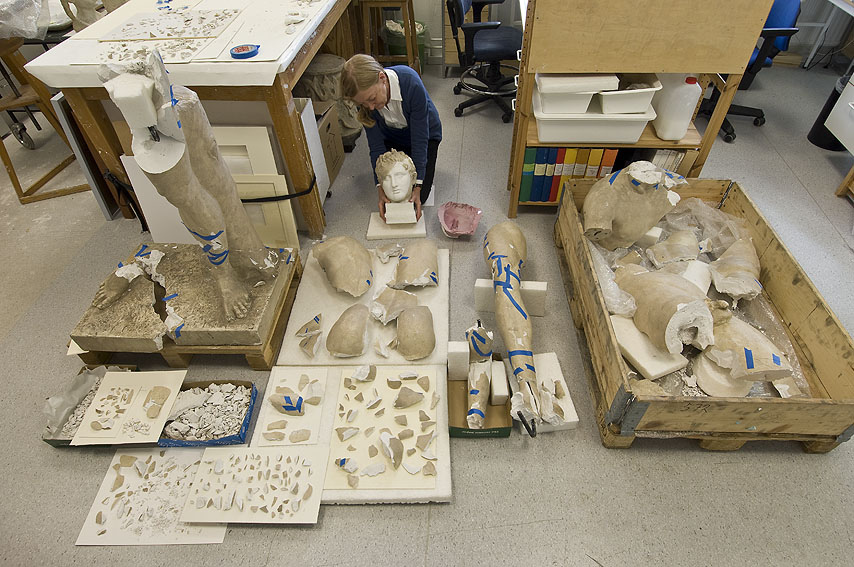INDIRA HOLZER details the daily adventures of a conservator.
The slightly vague idea of a conservator as a ‘preserver of culture’, digging up and revealing the dirty secrets of the past, is a common one, especially among dreamy journalists like me. No one really seems to know much about the specifics of what conservators do beyond the occasional anecdote. My only real knowledge has come from a friend, Max*, who works to repair and preserve culturally interesting objects at University College London’s Institute of Archaeology. Naturally however, what he tells me off-duty in coffee shops involves some element of fabrication, and journalists do of course have to stick with the truth. I therefore decided to shadow him for a day to investigate whether the secrets conservators discover about the past are really that ‘dirty’ at all.
I’ve picked an ordinary working day – a rather mundane one in comparison to what Max has seen and done before. He tells me that the most exciting moment of his career involved retrieving a couple of centuries-old letters from under some floorboards with his bare hands. On another occasion, he accidentally stumbled over some hidden mini drawers in the doors of a 17th century wardrobe.
As we begin our interview, Max is bending over a seemingly unexciting small ceramic sherd. With the conservator’s favourite instrument – the microscope – he shows us every tiny bit of it. He tells us about calcium, aluminium and silicon while our eyes wander around this laboratory, equipped with air suction tubes straight out of the nineties. The setting is strangely reminiscent of the Rocky Horror Picture Show, and for a short while we have trouble refocusing on Max’s table, with its solvents and scalpels. He fetches his personal leather toolkit, complete with a multitude of different brushes made out of squirrel or pig hair, and explains that conservation is very fluid in its philosophy. It works with highly destructive substances and sharp instruments, but at the same time treats the object of interest like the fragile feathers of a baby bird. There could always be something lurking undiscovered underneath or inside every archeological artifact found. Every piece of a piece is important, no matter how irrelevant it might seem.

His work as a conservator includes cleaning and analysing recently dug up objects, and preparing them for further transport, exhibitions or storage. When I ask Max to describe his profession in one sentence, he says that he ‘work[s] on tangible and intangible heritage, making sure present and future generations have access to and understand it’. He relates intangible heritage to the ideas and beliefs that come hand in hand with the objects he preserves, collaboration with curators, archeologists and specialised graphic designers. This is also where conservation divides into ‘people-based conservation’ and ‘material-based conservation’. UCL utilises the people-based framework, and as ‘half-time-scientists’ concerned with both scientific questions and working on real objects, Max and his team must delve into the deeper, more anthropological meaning behind each sherd.
After a brief chat with some students who are sorting out a collection of old Roman coins found on a site in south England, the official interview is over. We start talking more informally, and reflect on the human obsession with preserving our culture and, through this, ourselves. We are foolish creatures, believing that we might just win the race against time, provided we hire the best conservators. We are certainly getting better at ‘racing’ – we live longer and better because we have learned how to biologically manipulate life – but we still die. That’s where conservation and museums come in, making us as immortal as an invisible particle of a curtain or a chest of drawers, so to speak.
We should, therefore, be praising our conservators as heroes, – but there is not always much appreciation for to those who are doing the dirty work for us. Society does not pay them as well as it should, and no one seems to know much about the job profile in itself. How does Max feel about that? Not too bad, apparently: he loves his job and his ordinary life. It is enough for him to stand in the dirt and be the first person to discover the secrets of the past in hidden boxes. His next project will probably involve a trip to Norway to discover the ancient remains of a Viking ship. So, yes, the day to day work of a conservator is indeed dirty in its way. The secrets, not always.
* This is a pseudonym.
Featured image courtesy of Wikimedia Commons.





